铈镧比对CexNi0.5La0.5-xO系催化剂甘油氧化蒸汽重整制氢性能的影响
党成雄 杨浩波 余皓 王红娟 彭峰
(华南理工大学化学与化工学院,广州510640)
铈镧比对CexNi0.5La0.5-xO系催化剂甘油氧化蒸汽重整制氢性能的影响
党成雄杨浩波余皓*王红娟彭峰
(华南理工大学化学与化工学院,广州510640)
利用共沉淀法制备了CeO2和La2O3复合载体的CexNi0.5La0.5-xO(CeNiLaO)系催化剂,在固定床反应器中考察其甘油氧化蒸汽重整制氢(OSRG)性能,并采用X射线衍射(XRD)、程序升温还原(H2-TPR)、激光拉曼光谱(Raman)、扫描电子显微镜(SEM)、透射电子显微镜(TEM)和X射线光电子能谱(XPS)等手段对催化剂进行表征分析。结果表明:La2O3能够有效地分散Ni颗粒,减弱Ni颗粒在反应过程中的烧结,CeO2提供的晶格氧能够消除催化剂表面的积碳,同时La会部分进入Ce的晶格取代部分Ce4+造成晶格畸变,提高表面的氧空穴数。La2O3和CeO2的共同作用有利于减弱Ni因为烧结和积碳引起的失活。在不同Ce/La摩尔比的催化剂中,Ce0.4Ni0.5La0.1O表现出最好的催化活性,并且该催化剂在长达210 h的稳定性测试中,甘油的转化率都在95%以上,气相产物中的氢气浓度达50%。
氧化铈;氧化镧;镍;稳定性;甘油;制氢;蒸汽重整
1 Introduction
Hydrogen has been widely applied in fine chemicals and petroleum industries as a chemical raw material.Meanwhile,hydrogen is also considered as a potential clean and environmentalfriendly energy carrier,with high calorific value and zero pollution. At present,hydrogen is produced mainly by the steam reforming of natural gas in chemical industry.However,this process suffers from the unsustainable raw material and substantial carbon dioxide emissions.Renewable sources,especially those from biomass,are ideal feedstock to produce hydrogen,which makes this process sustainable and recycle CO2back to grow more biomass1.
Glycerol is the major by-product from the transesterification of fatty acids to manufacture biodiesel,providing about 10%as glycerol.With the rapid growth of biodiesel production,glycerol has been increasingly produced in recent years.Thus,the application of glycerol has constrained the development of biodiesel industry2.Conversion of glycerol to hydrogen is one of the most attractive ways to make use of glycerol,which can either alleviate the oversupply of glycerol,or afford a renewable hydrogen production independent on fossil fuels.
Hydrogen can be produced from glycerol by the steam reforming(SRG)reaction with catalysts.Noble metal catalysts,such as Pt,Ru,Rh,and Ir3-5,have been proved to be highly active for the SRG reaction,but are limited by the cost and resources. Compared with noble metal,Ni has attracted intensive research interests as a representative base metal catalyst6-9.Wu et al.6fabricated the supported Ni/Al2O3catalyst with different Ni precursors.Under the optimum conditions,the yield of H2was about 5.5 mol∙mol-1glycerol,approaching to the thermodynamic equilibriumvalue,5.7 mol∙mol-1.Wang et al.8developed a Ni-Mg-Al catalyst,which showed an optimal performance with the conversion of glycerol up to 88.0%and the yield of H2up to 78.5%at 650°C.However,Ni-based catalysts generally suffer from the rapid deactivation caused by sintering and coke deposition during the SRG reaction process10,11,which remains a major challenge for developing stable Ni-based catalysts.
It has been widely documented that an appropriate support is very important for the stability of Ni-based catalysts,because the supports may affect the metal dispersion and inhibit particle sintering and carbon formation12-15.Various oxides,including La2O3,Al2O3,CeO2,ZrO2,SiO2,and MgO,have been investigated as supports of nickel6,12,15,16.CeO2has excellent oxygen storagerelease capability by readily altering its oxidation states between Ce4+and Ce3+17.This property can be used to remove coke deposition on the metal surface and suppress deactivation.Gong et al.18studied the effect of CeO2on the performance of steam reforming of ethanol(SRE)over ceria-promoted Ni/SBA-15 catalysts and found that ceria promoter suppressed the coke formation on catalyst surfaces.Liu et al.19also found that at temperatures above 327°C,the lattice oxygen from ceria could eliminate the coke formed in the process of SRE.Our previous works3,11show that La2O3is beneficial for the redispersion of active metals,thereby slows the deactivation caused by sintering. Moreover,La2O3has a strong interaction with nickel at high temperatures through forming La-Ni-O phases,which stabilize the nickel20,21.The incorporation of La2O3could increase the dispersion of metallic Ni on Ni/γ-Al2O3and restrain the sintering of Ni particles,thus improve the stability of Ni/γ-Al2O3catalysts22.Both CeO2and La2O3could improve the stability of Ni-based catalysts as supports.Ce and La composite oxide may further enhance the stability as a catalyst carrier20,23.Venezia et al.20compared the catalytic behavior of Ni catalysts supported over CeO2,La2O3,and CeO2-La2O3mixed oxide in the methane partial oxidation reaction. It was found that in the presence of mixed CeO2-La2O3there was no coke formed.Arias et al.23also found that,when CeO2and La2O3co-existed simultaneously,the catalysts displayed excellent stability.In this work,we synthesized CexNi0.5La0.5-xO catalysts utilizing Ce and La composite oxide as a carrier via co-precipitation method and optimized the ratio of CeO2to La2O3,to enhance the stability of Ni-based catalysts for the oxidative steam reforming of glycerol(OSRG)reaction.
2 Experimental
2.1Preparation of catalysts
All the reagents are analytic pure and were purchased from Sinopharm Chemical Reagent Co.,Ltd.Catalysts in this paper were synthesized via a co-precipitation method.Typically,Ce(NO3)3∙6H2O,Ni(NO3)2∙6H2O and La(NO3)3∙nH2O were dissolved in deionized water with desired Ce2+/La3+molar ratios and a Ni content of 50%(atomic fraction)in final products,then the pH of the solution was adjusted to 11 by adding triethylamine solution dropwise.After continuously stirring for 4 h,the resulting white suspension was aged at room temperature for 2 h.The precipitates were filtered and washed with deionized water,followed by drying at 110°C for 12 h,and then calcined in air at 650°C for 6 h to obtain the catalysts.The samples were denoted as CexNi0.5La0.5-xO,where x represents the molar fraction of Ce.
2.2Characterizations
Specific surface areas of catalysts were measured by N2adsorption at-196°C(ASAP 2010,Micromeritics,America). Before the measurements,the samples were degassed at 300°C under vacuum overnight.Electron probe microanalysis(EPMA-1600,Shimadzu,Japan)was used to analyze the compositions of catalysts.Powder X-ray diffraction(XRD)measurements were performed in a Rigaku D/max-IIIAX diffractometer(Rigaku,Japan)using Cu Kαradiation(operating at 40 kV and 40 mA).H2temperature-programmed reduction(H2-TPR)was employed to analyze the reduction behavior of the catalysts in a TP5080 adsorption instrument(Xian Quan,China)equipped with a thermal conductivity detector(TCD).The hydrogen consumption was measured by calculating the reduction peaks in the range of 100-500°C referenced to the reduction peak of CuO as a standard material.X-ray photoelectron spectroscopy(XPS)was performed in a Kratos Axis ultra(DLD)spectrometer(Kratos,England)equipped with an Al KαX-ray source.The binding energies were referenced to the C 1s peak at 284.8 eV.Raman spectra were recorded on a LabRAM Aramis micro Raman spectrometer(Renishaw,England)with 633 nm wavelength laser and 2 μm spot size. Transmission electron microscopy(TEM)measurements were performed in a TECNAI10 microscope(Philips-FEI,Holland)equipped with an INCA energy dispersive spectrometer operatedat 200 kV.Specimens for TEM were prepared by ultrasonically suspending the sample in acetone and depositing a drop of the suspension onto a copper grid covered by amorphous carbon.SEM was performed in a LEO-1530VP microscope(LEO,German).
2.3Catalytic tests
The OSRG reaction was carried out in a quartz tubular reactor with inner diameter of 8 mm and length of 280 mm to evaluate the catalytic activity of the catalysts.The configuration and operation of reactor had been described in our previous work24.Before reaction,0.2 g catalyst was activated with H2at a flow rate of 30 mL∙min-1at 500°C for 20 min,then heated the reactor to the desired temperature under N2atmosphere.The gaseous products were analyzed by a gas chromatograph(He as carrier gas)equipped with a TCD and a flame ionization detector(FID).A TDX 01 column was used for H2,CO and CO2analysis in TCD. CH4and C2H4were analyzed by FID with a packed column for analyzing transformer oil.
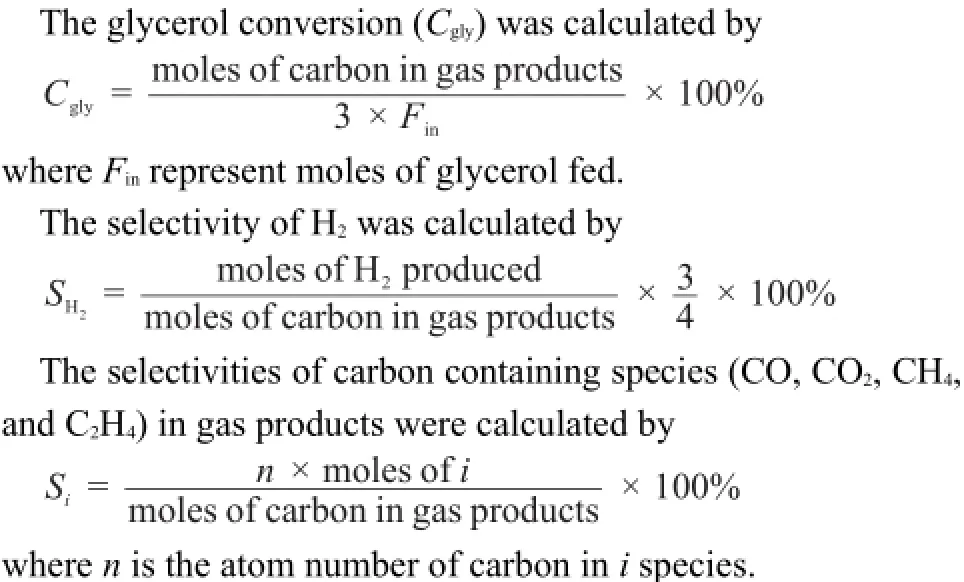
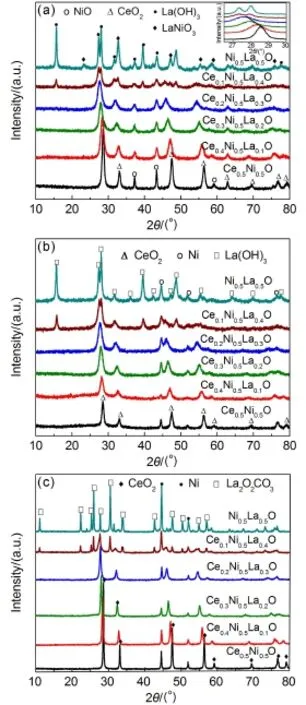
Fig.1 XRD patterns of(a)fresh,(b)reduced,and(c)used CexNi0.5La0.5-xO catalystsInset shows the characteristic peaks of CeO2shifting to low-angle region.
3 Results and discussion
3.1Catalyst characterizations
XRD patterns of fresh,reduced,and used catalysts with different Ce/La ratios are presented in Fig.1.CeO2,NiO,La(OH)3and some characteristic peaks from LaNiO3were detected in the fresh catalysts.As the content of La increases,the characteristic peaks of CeO2shift to low-angle region(see inset of Fig.1(a)). Meanwhile,there are no peaks from La species at lower La contents,indicating that some La ions may enter into the lattice of CeO2and induce a lattice distortion.In addition,the peaks of NiO gradually broaden with the introduction of La,proving that La2O3could increase the dispersion of NiO particles.The appearance of La(OH)3may be resulted from the reaction between La species and moisture.After H2reduction at 500°C,NiO turns into Ni completely(Fig.1(b)).La(OH)3would turn into La2O2CO3after the OSRG reaction(Fig.1(c)),probably through the decomposition of La(OH)3to La2O3and the carbonization of La2O3to La2O2CO33,24.
Table 1 summarizes the textual properties and crystallite sizes of fresh,reduced,and used catalysts with different Ce/La molar ratios.The Scherrer equation was used to estimate the mean crystallite size from the(111)diffraction peak of Ni or the(012)peak of NiO.The crystallite sizes of NiO and Ni decreased greatly after incorporating La,indicating the dispersion effect of La2O3on nickel.The smallest Ni crystallite size is reached over the Ce0.4Ni0.5La0.1O catalyst.In addition,the Ce0.4Ni0.5La0.1O also shows the highest specific surface area and pore volume.For all the catalysts,the sintering of Ni can be observed after the OSRG reaction,indicated by the increasing size of Ni particles.Nevertheless,the sintering of Ni particles would be somewhat retarded over the La-containing samples,indicated by the less increase of Ni particle size after the OSRG reaction,suggesting the improved thermal stability of catalyst22.
The TPR curves of CexNi0.5La0.5-xO catalysts are shown in Fig.2. The weak reduction peak below 300°C could be ascribed to the reduction of highly dispersed Ni species on surfaces25.The two overlapping peaks in the range of 300-500°C could be assigned as the reduction of Ni2+which has weak and strong interaction with support,respectively.The high temperature reduction peak of Ce0.5Ni0.5O at 800°C is from the reduction of Ce4+to Ce3+26,27,which is absent for other catalysts,probably due to the strongeras the reducible species,the H2comsuptions are very close to the theoretical values of CexNi0.5La0.5-xO(from 90.8 to 94.3 mL∙g-1).
As shown in Fig.3,the fresh CexNi0.5La0.5-xO catalysts display similar porous structures composed of aggregated particles.H2-reduction has little effect on the catalyst morphology.Ni crystallites can be observed in TEM images(Fig.4).Compared with Ce0.5Ni0.5O,the Ce0.4Ni0.5La0.1O is comprised of smaller particles,being consistent with the results of XRD.It should be noticed that the lattice spacing of the(200)planes of CeO2in the Ce0.4Ni0.5La0.1O is 0.284 nm(inset of Fig.4(b)),which is larger than pure CeO2(0.2706 nm,PDF#43-1002),indicating the substitution of La for Ce ions as revealed by XRDresults.The formation of Ce-La-O mixed oxides is also supported by the absence of any La species in the HR-TEM observation.
Fig.5 shows the Raman spectra of CexNi0.5La0.5-xO catalysts and pure CeO2.Because of the intense fluorescent effect of La species on Raman spectra,the measurements were conducted for the samples with x<0.3 to avoid the excessive amounts of La.The band at 464 cm-1could be ascribed to the F2gvibration mode of fluorite structure of CeO228.When the amount of La increased,the band shifted to lower wave numbers,which may be caused by the metal-support interaction(MSI)over the mixed oxides.The strongest MSI is achieved on the composition of Ce0.4Ni0.5La0.1O,evidenced by the highest reduction peak temperature.Considering the refractory nature of La,the minor peaks of Ni0.5La0.5O in the range from 500 to 650°C can be attributed to the decomposition of La2O2CO33.The H2comsuptions were calculated by integrating the peaks from room temperature(r.t.)to 500°C.Assuming Ni2+incorporation of heteroatom ions into the lattice of CeO229.Herein,we conclude that the shift probably stems from the incorporation of La or Ni as revealed by aforementioned analysis.Two overlapping bands in the range of 500-650 cm-1can be observed for all the CexNi0.5La0.5-xO catalysts.The band at 545 cm-1could be attributed to the O2-vacancy on catalyst surfaces,and the one at 615 cm-1could be ascribed to the vacancy-interstitial oxygen defects in ceria30.As shown in Fig.5,either La or Ni would create oxygen vacancies on catalyst surfaces,and the strong intensity of the defect-related bands of Ce0.3Ni0.5La0.2O suggests that the amount of oxygen vacancies could be tuned by catalyst composition.

Table 1Compositions and physical properties of the fresh,reduced,and used CexNi0.5La0.5-xO catalysts
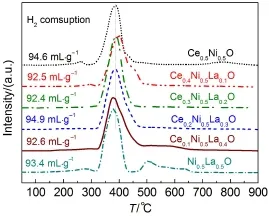
Fig.2H2-TPR profiles of CexNi0.5La0.5-xO catalysts
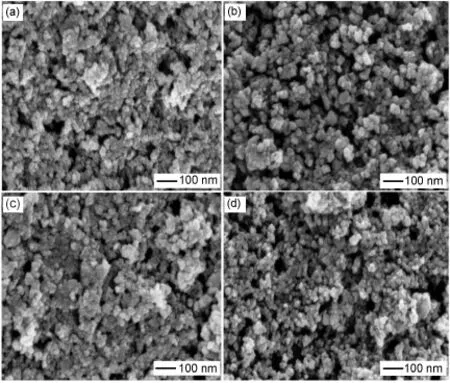
Fig.3SEM images of fresh(a)and reduced(b)Ce0.5Ni0.5O,fresh(c)and reduced(d)Ce0.4Ni0.5La0.1O catalysts
Fig.6 reports the XPS spectra of CexNi0.5La0.5-xO in the O 1s binding energy(BE)regions.The XPS spectra exhibit similar broad doublet peaks in all catalysts.The lower BEs can be assigned to lattice oxygen(labeled as OI)and the BEs with higher values are attributed to other surface oxygen species(labeled as OII)31-33.The surface oxygens(OII)increase with the incorporation of La34because of the formation of La(OH)3or La2O2CO3,as revealed by XRD,but,the amount of lattice oxygen changes in a contrary tendency.The results indicate La would increase the amount of OII and Ce could improve OI.Meanwhile,the shift of BE of OI toward lower values with incorporating La3+,see the cases x=0.1,0.2,0.3,indicates that La ions have entered into the lattice of CeO232,which is agreement with the analysis of XRD,HR-TEM,and Raman spectroscopy.
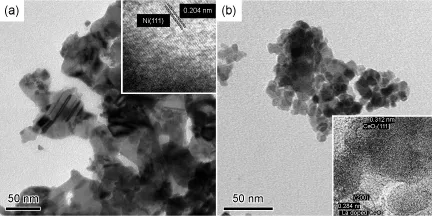
Fig.4TEM images of reduced(a)Ce0.5Ni0.5O and(b)Ce0.4Ni0.5La0.1O and HR-TEM images of used Ce0.4Ni0.5La0.1O after OSRG reaction reaction conditions:T=650°C,carbon-to-oxygen molar ratio=1,steam-to-carbon molar ratio=4,GHSV=60000 h-1,t=210 h
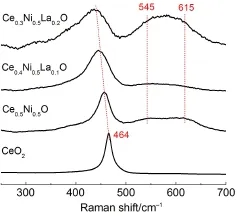
Fig.5Raman spectra of pure CeO2and CexNi0.5La0.5-xO catalysts
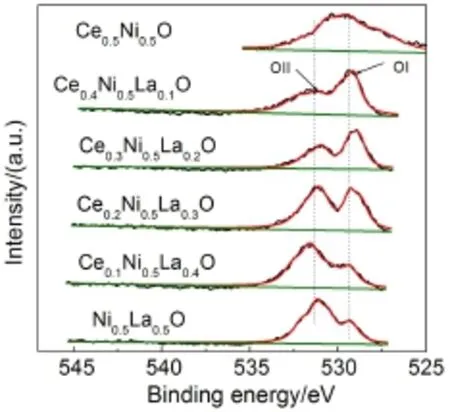
Fig.6O 1s XPS spectra of fresh CexNi0.5La0.5-xO catalysts

Table 2Catalytic performance of CexNi0.5La0.5-xO catalysts in SRG and oxidative SRG(OSRG)
3.2Catalytic performance of CexNi0.5La0.5-xO catalysts OSRG and SRG reactions were performed under the optimized conditions established in our previous work3.Table 2 compares their catalytic performances.In SRG,Ce0.4Ni0.5La0.1O showed the best activity,indicated by the highest conversion of glycerol andmuch lower selectivity of C2H4.Since C2H4is a typical precursor of polymerized condensation resulting in carbon deposition,the lower selectivity of C2H4links to the better stability against coking.Introduction of oxygen could relieve the deactivation by coking and improve the thermodynamic equilibrium conversion of reaction system3.Therefore,all the catalysts displayed the higher activity in OSRG.Meanwhile,Ce0.4Ni0.5La0.1O still performed the best.It is worth pointing out that Ce0.4Ni0.5La0.1O also presented very high yield of H2.In the case of OSRG,the H2STY value could reach 13.4 L∙g-1∙h-1.In the case of SRG,a very high STY value could be reached at 21.6 L∙g-1∙h-1,which is much higher than most of literature35.According to the results of catalyst characterizations,two reasons may be responsible for the high performance of Ce0.4Ni0.5La0.1O,detailed as follows:(i)the existence of La2O3could increase the dispersity of metallic Ni and enhance the MSI,thus suppress the sintering of metallic Ni particles;(ii)the lattice oxygen from CeO2could inhibit the coke formation and facilitate the removal of coke simultaneously on the catalyst surfaces.The substitution of La for Ce would improve the amount of the surface oxygen.However,the excessive La would decrease the activity due to the decreased lattice oxygen,specific surface area and pore volume.This has also been proved by Xu et al.22.
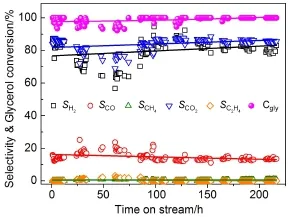
Fig.7Stability test of Ce0.4Ni0.5La0.1O in the OSRG reaction reaction conditions:T=650°C,carbon-to-oxygen molar ratio=1,steam-to-carbon molar ratio=4,GHSV=60000 h-1
The Ce0.4Ni0.5La0.1O catalyst was subjected to a long-term stability test for 210 h.As shown in Fig.7,Ce0.4Ni0.5La0.1O showed an excellent stability,indicated by the high conversion of glycerol above 95%and the steady production of H2-enriched gas with about 85%H2selectivity(~50%purity)during the 210 h time on stream.At the meantime,the concentrations of CH4and C2H4stayed very low(less than 0.3%).The aforementioned results demonstrated that the Ce0.4Ni0.5La0.1O catalyst can be used as an efficient and stable material for reforming glycerol to produce hydrogen-enriched gas.
4 Conclusions
We synthesized CexNi0.5La0.5-xO catalysts utilizing Ce and La composite oxides as carrier via co-precipitation method and studied the effect of Ce to La ratios on the catalytic performance in reforming glycerol for hydrogen production.Catalyst characterizations indicate that La2O3could disperse and stabilize Ni particles.The substitution of La for Ce would increase the amount of the oxygen species on catalyst surfaces.The synergy of La2O3and CeO2could prevent the Ni-based catalyst from deactivation caused by the sintering and coke deposition.Ce0.4Ni0.5La0.1O was the optimal catalyst,because of the highest lattice oxygen concentration,surface area,the strong MSI and the smallest Ni particle size.The conversion of glycerol retained no change above 95%and the H2concentration was maintained around 50%in a long-term stability test for 210 h.Our work suggests the Ce-La composite is promising as a support of Ni-based catalysts to achieve a highly efficient and stable catalyst for the OSRG reaction.
References
(1)Yang,G.X.;Lai,C.F.;Li,S.;Yu,H.;Peng,F.Industrial Catal. 2010,18,1.[杨光星,赖超凤,李爽,余皓,彭峰.工业催化,2010,18,1.]
(2)Dou,B.L.;Chen,H.S.Chem.Ind.Eng.Prog.2011,30,967.[豆斌林,陈海生.化工进展,2011,30,967.]
(3)Huang,X.Y.;Dang,C.X.;Yu,H.;Wang,H.J.;Peng,F.ACS Catal.2015,5,1155.doi:10.1021/cs5014305
(4)Slinn,M.;Kendall,K.;Mallon,C.;Andrews,J.Bioresource Technol.2008,99,5851.doi:10.1016/j.biortech.2007.10.003
(5)Hirai,T.;Ikenaga,N.;Miyake,T.;Suzuki,T.Energy&Fuels 2005,19,1761.doi:10.1021/ef050121q
(6)Wu,G.W.;Zhang,C.X.;Li,S.R.;Han,Z.P.;Wang,T.;Ma,X. B.;Gong,J.L.ACS Sustain.Chem.Eng.2013,1,1052. doi:10.1021/sc400123f
(7)Wu,G.W.;Li,S.R.;Zhang,C.X.;Wang,T.;Gong,J.L.Appl. Catal.B 2014,144,277.doi:10.1016/j.apcatb.2013.07.028
(8)Wang,C.;Dou,B.L.;Chen,H.S.;Song,Y.C.;Xu,Y.J.;Du,X.;Luo,T,T.;Tan,C.Q.Chem.Eng.J.2013,220,133. doi:10.1016/j.cej.2013.01.050
(9)Li,L.;Guo,W.L.;Li,J.L.;Dai,X.;Zhu,H.;Wang,X.B.;Deng,X.Z.Chem.Ind.Eng.Prog.2013,32,122.[李磊,郭瓦力,李俊磊,戴玺,朱虹,王晓冰,邓信忠.化工进展,2013,32,122.]
(10)Ma,H.Y.;Zeng,L.;Tian,H.;Li,D.;Wang,X.;Li,X.Y.;Gong,J.L.Appl.Catal.B 2016,181,321.doi:10.1016/j. apcatb.2015.08.019
(11)Chen,H.Q.;Yu,H.;Peng,F.;Yang,G.X.;Wang,H.J.;Yang,J.;Tang,Y.Chem.Eng.J.2010,160,333.doi:10.1016/j. cej.2010.03.054
(12)Yang,Y.;Wu,F.;Ma,J.X.Chin.J.Catal.2005,26,131.[杨宇,吴绯,马建新.催化学报,2005,26,131.]
(13)Jiang,H.T.;Hua,W.;Ji,J.B.Prog.Chem.2013,25,859.[姜洪涛,华炜,计建炳.化学进展,2013,25,859.]
(14)Srinivas,D.;Satyanarayana,C.V.V.;Potdar,H.S.;Ratnasamy,P.Appl.Catal.A 2003,246,323.doi:10.1016/S0926-860X(03)00085-1
(15)Nichele,V.;Signoretto,M.;Menwgazzo,F.;Gallo,A.;Santo,V. D.;Cruciani,G.;Cerrato,G.Appl.Catal.B 2012,111-112,225. doi:10.1016/j.apcatb.2011.10.003
(16)Adhikari,S.;Fernando,S.D.;Haryanto,A.Renew.Energy 2008,33,1097.doi:10.1016/j.renene.2007.09.005
(17)Soykal,I.I.;Sohn,H.;Singh,D.;Miller,J.T.;Ozkan,U.S.ACS Catal.2014,4,585.doi:10.1021/cs400908h
(18)Li,D.;Zeng,L.;Li,X.Y.;Wang,X.;Ma,H.Y.;Assabumrungrat,S.;Gong,J.L.Appl.Catal.B 2015,176-177,532.doi:10.1016/j.apcatb.2015.04.020
(19)Liu,Z.Y.;Duchon,T.;Wang,H.R.;Peterson,E.W.;Zhou,Y. H.;Luo,S.;Zhou,J.;Matolin,V.;Stacchiola,D.J.;Rodriguez,J.A.;Senanayake,S.D.J.Phys.Chem.C 2015,119,18248. doi:10.1021/acs.jpcc.5b04310
(20)Pantaleo,G.;Parola,V.L.;Deganello,F.;Calatozzo,P.;Bal,R.;Venezia,A.M.Appl.Catal.B 2015,164,135.doi:10.1016/j. apcatb.2014.09.011
(21)Tsipouriari,V.A.;Verykios,X.E.J.Catal.1998,179,292. doi:10.1006/jcat.1998.2183
(22)Xu,J.K.;Ren,K.W.;Wang,X.L.;Zhou,W.;Pan,X.M.;Ma,J.X.Acta Phys.-Chim.Sin.2008,24,1568.[徐军科,任克威,王晓蕾,周伟,潘相敏,马建新.物理化学学报,2008,24,1568.]doi:10.3866/PKU.WHXB20080907
(23)Miletić,N.;Izquierdo,U.;Obregón,I.;Bizkarra,K.;Agirrezabal-Telleria,I.;Bario,L.V.;Arias,P.L.Catal.Sci. Technol.2015,5,1704.doi:10.1039/c4cy01438c
(24)Yang,G.X.;Yu,H.;Huang,X.Y.;Peng,F.;Wang,H.J.Appl. Catal.B 2012,127,89.doi:10.1016/j.apcatb.2012.08.003
(25)Jalowiecki-Duhamel,L.;Zarrou,H.;DʹHuysser,A.Int.J. Hydrog.Energy 2008,33,5527.doi:10.1016/j. ijhydene.2008.07.031
(26)Xu,S.;Wang,X.L.Fuel 2005,84,563.doi:10.1016/j. fuel.2004.10.008
(27)Fornasiero,P.;Dimonte,R.;Rao,G.R.;Kaspar,J.;Meriani,S.;Trovarelli,A.;Graziani,M.J.Catal.1995,151,168. doi:10.1006/jcat.1995.1019
(28)Reddy,B.M.;Khan,A.;Lakshmanan,P.;Aouine,M.;Loridant,S.;Volta,J.C.J.Phys.Chem.B 2005,109,3355.doi:10.1021/ jp045193h
(29)Liu,Y.M.;Wang,L.C.;Chen,M.;Xu,J.;Cao,Y.;He,H.Y.;Fan,K.N.Catal.Lett.2009,130,350.doi:10.1007/s10562-009-9977-z
(30)Wang,S.Y.;Li,N.;Luo,L.F.;Huang,W.X.;Pu,Z.Y.;Wang,Y.J.;Hu,G.S.;Luo,M.F.;Lu,J.Q.App.Catal.B 2014,144,325.doi:10.1016/j.apcatb.2013.07.037
(31)Piumetti,M.;Bensaid,S.;Russo,N.;Fino,D.Appl.Catal.B 2016,180,271.doi:10.1016/j.apcatb.2015.06.018
(32)Liu,F.;Zhao,L.;Wang,H.;Bai,X.;Liu,Y.Int.J.Hydrog. Energy 2014,39,10454.doi:10.1016/j.ijhydene.2014.05.036
(33)Han,X.;Yu,Y.B.;He,H.;Shan,W.P.Int.J.Hydrog.Energy 2013,38,10293.doi:10.1016/j.ijhydene.2013.05.137
(34)Yan,Y.;Yang,Z.Z.;Xu,H.D.;Xu,B.Q.;Zhang,Y.H.;Gong,M.C.;Chen,Y.Q.Acta Phys.-Chim.Sin.2015,31,2358.[杨怡,杨铮铮,徐海迪,徐宝强,张艳华,龚茂初,陈耀强.物理化学学报,2015,31,2358.]doi:10.3866/PKU.WHXB201510135
(35)Lin,Y.C.Int.J.Hydrog.Energy 2013,38,2678.doi:10.1016/j. ijhydene.2012.12.079
CexNi0.5La0.5-xO Catalysts for Hydrogen Production by Oxidative Steam Reforming of Glycerol:Influence of the Ce-to-La Ratio
DANG Cheng-XiongYANG Hao-BoYU Hao*WANG Hong-JuanPENG Feng
(School of Chemistry and Chemical Engineering,South China University of Technology,Guangzhou 510640,P.R.China)
CexNi0.5La0.5-xO(CeNiLaO)catalysts were synthesized using a Ce-La composite oxide as the carrier via co-precipitation.They were applied in the oxidative steamreforming of glycerol(OSRG)in a fixed-bed reactor. The catalysts were characterized by X-ray diffraction(XRD),H2-temperature-programmed reduction(H2-TPR),Raman spectroscopy,scanning electron microscopy(SEM),transmission electron microscopy(TEM),and X-ray photoelectron spectroscopy(XPS).The results showed that La2O3improved the dispersion of metallic Ni and suppressed the sintering of metallic Ni particles;the lattice oxygen of CeO2inhibited and eliminated carbon deposition on the surface of the catalysts;and the substitution of some La3+for Ce4+ions induced a distortion of the lattice.The synergy of La2O3and CeO2lessened the deactivation caused by the sintering and coke deposition and improved the catalytic performance.Among the catalysts with different molar ratios of Ce to La,Ce0.4Ni0.5La0.1O had the best catalytic activity.The conversion of glycerol remained above 95%after a 210 h stability test,while a gaseous reformate of about 50%hydrogen could be steadily produced.
CeO2;La2O3;Ni;Stability;Glycerol;Hydrogen production;Steam reforming
January 4,2016;Revised:March 15,2016;Published on Web:March 16,2016.
O643
[Article]10.3866/PKU.WHXB201603161www.whxb.pku.edu.cn
*Corresponding author.Email:yuhao@scut.edu.cn;Tel/Fax:+86-20-87114916.
The project was supported by the National Natural Science Foundation of China(20176094),Program for New Century Excellent Talents in University of Ministry of Education of China(NCET-12-0190),and Pearl River Nova Program of Guangzhou City,China(2011J2200062).
国家自然科学基金(20176094),教育部新世纪优秀人才支持计划项目(NCET-12-0190)和广州市珠江科技新星项目(2011J2200062)资助
©Editorial office ofActa Physico-Chimica Sinica

